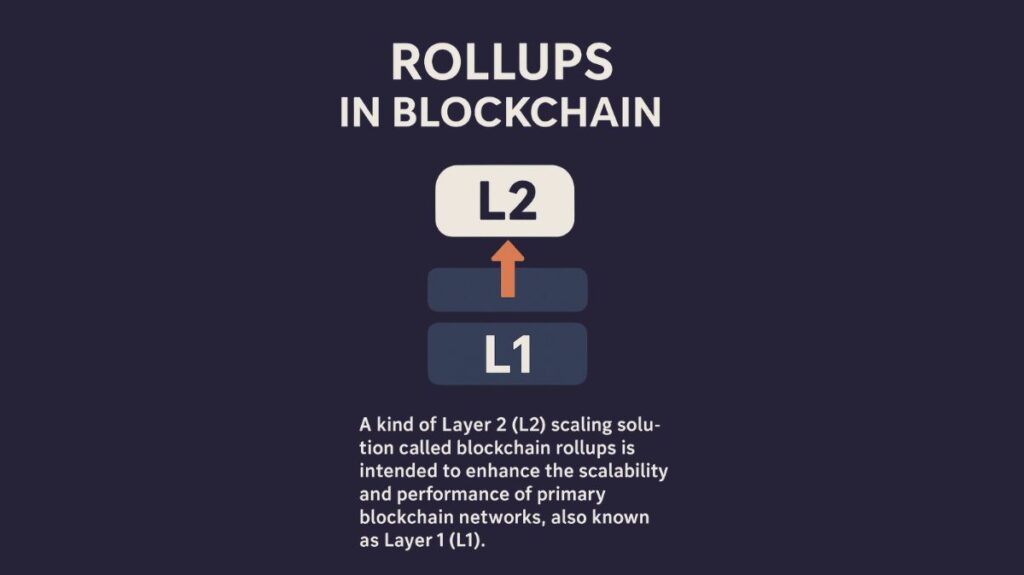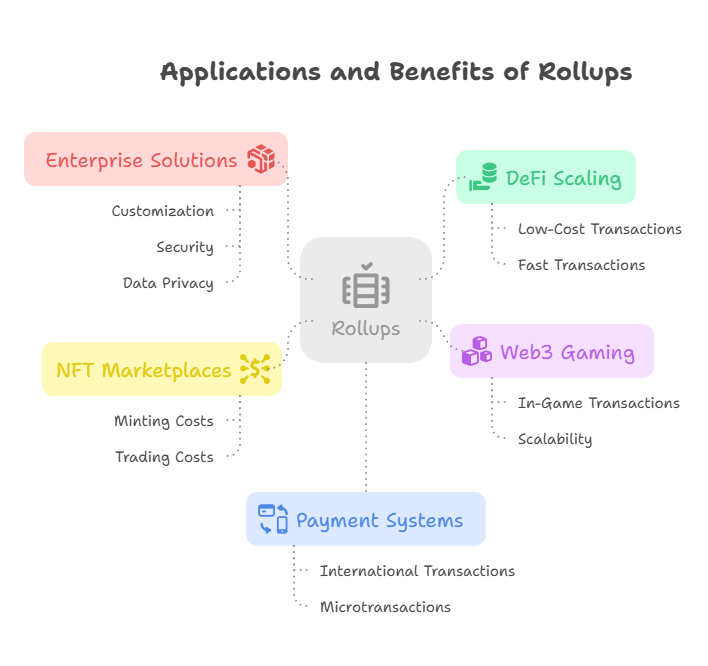Rollup in Blockchain

A kind of Layer 2 (L2) scaling solution called blockchain rollups is intended to enhance the scalability and performance of primary blockchain networks, also known as Layer 1 (L1). They solve the scalability issues that public blockchains encounter, like low transaction throughput and expensive transaction fees brought on by congestion.
Here’s a detailed explanation of blockchain rollups:
What are Blockchain Rollups?
Off-chain processing of a sizable number of transactions is how blockchain rollups operate. For submission back to the main Layer 1 (L1) chain, they “roll up” or combine several off-chain transactions into a single, compressed “rollup.” Effectively, this procedure removes transactions from the mainnet, handles them independently, combines them into a single piece of data, and then returns them to the parent chain. By spreading the petrol tax over all transactions in the rollup, users’ per-transaction costs are greatly decreased. Rollups receive Ethereum blockchain security by sending transactions to the L1.
Why are Rollups Needed?
A basic constraint known as the “blockchain trilemma” frequently plagues blockchains, such as Ethereum. According to this conundrum, a blockchain system can only accomplish two of the three characteristics: security, scalability, and decentralization. Due to its emphasis on security and decentralization, Ethereum has typically had high gas prices and sluggish transaction processing as network activity grows. Since Ethereum can only handle 15 transactions per second, as its popularity rises, more people are requesting transactions, which raises petrol costs as people “jump the queue” to avoid lengthy wait periods. Rollups seek to resolve this conundrum by boosting Ethereum throughput without compromising security or decentralization.
How do Blockchain Rollups Work?
The fundamental process for all rollups involves several steps:
- Off-Chain Execution: Transactions are sent by users to the rollup network (the Layer 2), where they are processed off-chain by an “operator,” a node, group of components, or entity.
- Batching is the process by which the operator gathers a significant number of these off-chain transactions and combines them into one batch.
- Compression: The operator compresses the bundled transactions.
- On-Chain Submission: On the main Layer 1 blockchain, a smart contract receives the compressed batch of transactions as a single transaction, together with cryptographic evidence of their authenticity.
- Data Availability: In order to provide security and resistance to censorship, the raw transaction data is also put on the main chain. This is essential since it enables anybody to reconstruct the rollup’s state and confirm the transactions’ integrity.
- Verification and Settlement: The main blockchain verifies the batch or proof that was uploaded. While ZK-rollups use cryptographic validity proofs, optimistic rollups use a fraud-proof technique.
You can also read What Is Binance Web3 Wallet And Binance Wallet In Blockchain
Types of Blockchain Rollups
There are two primary types of rollups, distinguished by how they verify the validity of off-chain transactions:
Optimistic Rollups:
- How they work: These rollups optimistically assume all transactions executed on the L2 are valid by default. They send batches of transactions to the L1 without immediate verification.
- Fraud Detection (Fraud Proofs): After a batch is submitted, there is a “challenge period” (usually one to two weeks) to guarantee integrity. Any operator has this window of opportunity to contest a transaction by presenting a “fraud-proof.” If a fraud-proof is successful, the operator who made the mistake is punished (for example, their staked deposit is “slashed”), the invalid batch is reverted, and the rollup re-executes the transaction batch.
- Advantages: Widely utilized and comparatively easy to adopt. Their capacity to roll up thousands of transactions off-chain greatly facilitates scalability, and they can realistically process 500 transactions per second (TPS).
- Disadvantages: The main drawback is the long withdrawal period due to the dispute window; users must wait for the challenge period to end before withdrawing funds to the main chain. They also have increased chances of fraud if there’s a lack of honest validators.
- Examples: Optimism, Arbitrum, Base L2
Zero-Knowledge (ZK) Rollups:
- How they work: Unlike Optimistic Rollups, ZK-Rollups prove each batch of transactions correct by having a “validity proof” (or ZK-proof) submitted on-chain for every batch. This proof mathematically guarantees that the transactions are valid and were executed correctly.
- Validity Proofs: For every transaction batch, a “prover” calculates a ZK-proof, which the L1 smart contract (the “verifier”) subsequently confirms. The ZK-proof verifies the legitimacy of the transaction without disclosing any information about it. Without having to carry out each transaction again, the L1 smart contract effectively validates this proof.
- Techniques: Some techniques include zk-SNARKs (Zero-Knowledge Succinct Non-Interactive Arguments of Knowledge) and zk-STARKs (Zero-Knowledge Scalable Transparent Arguments of Knowledge).
- ZK-SNARKs: renowned for their fast processing speed and constant-time verification, and minimal proof sizes. Though they can be vulnerable to hacks using quantum computing, they guarantee security and anonymity.
- Better scalability and transparency are characteristics of ZK-STARKs, which are more current and enhanced versions of ZK-SNARKs. They rely on no one they can trust. They can produce larger proof sizes that need more time to verify than ZK-SNARKs, despite producing proofs more quickly.
- Advantages: Since validity is established mathematically before submission, withdrawals to the main chain offer nearly immediate finality. Additionally, they are very safe. They have a TPS of about 2,000 transactions per second.
- Disadvantages: Much more complicated and computationally demanding to set up and operate. It takes sophisticated cryptography and specialized technology to generate proofs. Their interoperability with certain decentralized applications (dApps) can be limited.
- Examples: zkSync Era, Starkware’s StarkEx, Polygon CDK, Immutable X, Loopring.
Rollup Operators
Different types of operators perform various actions within rollup solutions:
- Validators: Provide a stake that can be “slashed” if they behave maliciously, and suggest fresh rollup blocks. A whitelisted validator system is employed by Arbitrum.
- Sequencers: Arrange transactions, group them, and occasionally carry them out before sending bundles to the L1. Centralized or decentralized systems are both possible. Sequencers are used by Arbitrum and zkSync Era.
- Provers: In ZK Rollups, they generate and submit zero-knowledge proofs. ZkSync Era uses provers.
- Proposers: Propose the current valid state of the rollup chain, used in rollups like Scroll and Optimism.
- Batchers or Aggregators: Bundle transactions together, as seen in Optimism.
You can also read Unconfirmed Bitcoin Transactions And Core Concepts In It
Stages of Rollups
Rollups are categorized into maturity stages based on decentralization and security features, as proposed by Vitalik Buterin and assessed by the L2BEAT team:
- Stage 0 (Full Training Wheels): Operators predominantly manage the rollup, but the state can be reconstructed from L1 data.
- Stage 1 (Enhanced Rollup Governance): Governed by smart contracts, with a Security Council for bugs, a fully functional proof system (fraud/validity), and user exit options without operator coordination.
- Stage 2 (No Training Wheels): Completely controlled by smart contracts, featuring a mechanism that protects users against governance attacks and provides permissionless fraud and validity proofing.
Applications and Benefits of Rollups

Applications and Benefits of Rollups
Rollups are widely applied across various sectors:
- DeFi Scaling: Provide low-cost, fast transactions for lending platforms and decentralized exchanges.
- Web3 Gaming and Virtual Worlds: Support fast and frequent in-game transactions without large gas fees, enhancing scalability for blockchain-based games.
- NFT Marketplaces: Reduce minting and trading costs for NFTs.
- Payment systems: Enable international and microtransactions.
- Enterprise Solutions & Supply Chain Management: Allow for customization, higher security, data privacy, and efficient tracking and validation of transactions.
The benefits include increased scalability, low transaction fees, faster transaction processing, enhanced privacy (especially with ZK-rollups), and an overall improved user experience by resolving blockchain scalability issues.
Challenges and Future of Rollups
Despite their efficiency, rollups face challenges, including interoperability between different L2 chains, complex user experience (UX) when bridging assets, initial centralization risks with sequencers, and the need for dApp developers to adapt smart contracts.
The future of rollups is promising, with expectations that they will be a cornerstone of DeFi and NFTs, supporting fast and cost-efficient transactions across various blockchains. Trends include increased adoption of ZK-Rollups, enhanced interoperability, the exploration of hybrid rollup models, and a growing Layer 2 ecosystem. Breakthroughs like zkEVM (Zero-Knowledge Ethereum Virtual Machine) enable full compatibility with Ethereum smart contracts, further scaling Ethereum. Rollups are expected to play a bigger role in the DeFi space and integrate with Ethereum’s future upgrades like sharding, leading to more effective and scalable solutions.
You can also read Proof of Ownership Blockchain, How it Works, & Applications
